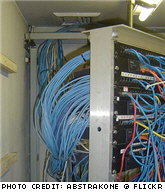 For as long as anyone could remember, there had always been two server rooms: the Cool Room and the Hot Room. The Cool Room was exactly what you’d expect a server room at a mid-sized technology services firm to be: floor-to-ceiling racks along the walls filled with various servers, battery backups, monitors, and KVMs, all tied together with Ethernet and power cables that were neatly tucked in their trays. And, of course, it was a cool 65°F thanks to a pair of dedicated air conditioning units.
For as long as anyone could remember, there had always been two server rooms: the Cool Room and the Hot Room. The Cool Room was exactly what you’d expect a server room at a mid-sized technology services firm to be: floor-to-ceiling racks along the walls filled with various servers, battery backups, monitors, and KVMs, all tied together with Ethernet and power cables that were neatly tucked in their trays. And, of course, it was a cool 65°F thanks to a pair of dedicated air conditioning units.
The Hot Room, on the other hand, was more like a server closet. It was a cramped 8’ by 10’ room that housed core telecommunications equipment including the firewalls, routers, switches, VPN concentrators, and the PBX system. This room also served as the central hub for the facility’s wiring and had hundreds of cat5 cable running through countless junction boxes. And, of course, it was a sweltering 98°F thanks to all of the equipment that had become even hotter to the touch.
Ted, who had recently joined the firm as an IT Director, was a bit uncomfortable with this setup. Not only did the Hot Room house nearly half a million dollars worth of gear, but if any one of the core components – such as the core router or PBX – failed from overheating, it would be a business catastrophe. He asked Aaron, the network operations manager, for some more background.
“Believe you me,” Aaron explained, clearly used to answering the what’s-up-with-the-Hot-Room question, “we’ve tried for years to get this resolved. What it comes down to, quite simply, is cost. One-hundred and seventy-eight thousand dollars. Even the CTO couldn’t get that amount approved.”
“But,” Ted instinctually questioned, “wouldn’t it cost more than—”
“Cost more than in an outage, you mean?” Aaron interrupted, “yeah, it could. But, then again, it might not. They’re willing to risk it, I guess.”
“Okay,” Ted paused for a moment, “can’t you just move–”
“Move the equipment upstairs to the Cool Room?” Aaron interrupted again, finishing Ted’s sentence, “we’ve already moved what we could. But with everything terminating here, the switches and routers have to stay.”
That made some sense. Ted pondered the problem for another few seconds and then asked, “how about a portable or duct–?”
“Ductless A/C?” Aaron jumped in, “the problem with those – or the portables – is we’ve got no place to vent or drain. So, if we went that route, it’d just be easier to place a few units on the roof. Plus, the portables are all fairly limited when it comes to BTU.”
Ted couldn’t think of any more ideas off the top of his head. Since the Hot Room hadn’t overheated once over the past few years, he felt safe knowing that it probably wouldn’t overheat in the next few weeks. That’d give him plenty of time to come up with a solution that cost less $178,000.
The next day, Ted stopped by their building’s maintenance office to see if the superintendent could help come up with a creative way to duct some cool air in the Hot Room without breaking the bank. Within the hour, the superintendent met Ted in the lobby and they walked over to the Hot Room.
“So we’ve got a bunch of telcom stuff in here,” Ted explained while he unlocked the door. A gust of warm air greeted both Ted and the super when the door opened. “I’m worried that some of it will over–”
“Jeeze oh man!” the superintendent exasperated, “it’s pretty toasty in here. Hang on a sec.”
The super walked down the hall, rifling through a ring of keys, and disappeared around the corner. About sixty seconds later, a blast of cold air came pouring through the ceiling vents. Ted looked up at the ceiling and couldn’t help but stare in awe.
“Yep, that’ll do it,” the superintendent said when he returned a few moments later, “you had a tripped breaker on the VAV box. Hope it wasn’t bothering you for too long.”
By the end of the day, it was a nice 65°F in the Hot Room.

